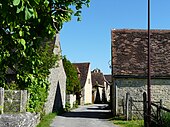Fanlac
| Fanlac | ||
|---|---|---|
|
|
||
| region | Nouvelle-Aquitaine | |
| Department | Dordogne | |
| Arrondissement | Sarlat-la-Canéda | |
| Canton | Vallée de l'Homme | |
| Community association | Vallée de l'Homme | |
| Coordinates | 45 ° 4 ′ N , 1 ° 6 ′ E | |
| height | 97-267 m | |
| surface | 14.37 km 2 | |
| Residents | 139 (January 1, 2017) | |
| Population density | 10 inhabitants / km 2 | |
| Post Code | 24290 | |
| INSEE code | 24174 | |
| Website | http://fanlac.jimdo.com/ | |
 Center with parish church and stone cross |
||
Fanlac ( Occitan : identical) is a place and a municipality in southwestern France with 139 inhabitants (as of January 1, 2017) in the old cultural landscape of the Périgord in the Dordogne department in the Nouvelle-Aquitaine region .
location
The small town of Fanlac is located about one kilometer west of the Thonac river at an altitude of about 220 m above sea level. d. M. and about 38 kilometers (driving distance) northwest of Sarlat-la-Canéda and about 42 kilometers southeast of Périgueux . The canton capital Montignac is about eight kilometers to the east. Several hamlets and farmhouses also belong to the community .
Population development
| year | 1968 | 1975 | 1982 | 1990 | 1999 | 2006 | 2012 |
| Residents | 170 | 144 | 147 | 158 | 142 | 142 | 130 |
In the 19th century the population of the community was always between 500 and 650. The phylloxera crisis in viticulture and the loss of jobs due to the mechanization of agriculture led to a continuous decline in population, the low point of which still does not seem to have been reached.
economy
Up to the present day agriculture plays the biggest role in the economic life of the municipality. However, the viticulture operated here was completely given up after the phylloxera crisis towards the end of the 19th century. Tobacco and corn are also on the decline - instead fields and pastures, but also walnut , chestnut and fruit trees dominate the region. Also, foie gras and truffles are among the best regional cuisine. Some vacant houses are rented out as holiday apartments ( gîtes ).
history
The first written mention of the place belonging to the castellany of Montignac under the name Fallacum comes from the 13th century; however, the church is dated as early as the 12th century. In 1625 one was Benedictine - Convention founded. During the Second World War , communists and other undesirable people were interned in the Château de Sablou .
Attractions

- The alleys in the town center ( bourg ) of Fanlac are ideal for short walks.
- The towering single-nave parish church ( Église de la Décollation-de-Saint-Jean-Baptiste ) is dated to the 12th century and was originally dedicated to the birth of Our Lady of God ( Notre-Dame-de-la-Nativité ). The Romanesque building, designed as a fortified church , was modernized several times in the 16th and 18th centuries; The entire design of the west facade with the rounded bell gable dates from 1704. In the north wall of the church there is a small figure relief, which - according to local tradition - Jean de La Jalage , a defender of the church during the Hundred Years War (1337-1453) is supposed to represent. The church building was classified as a monument historique in 1970 .
- The front of the late Gothic stone cross in front of the church , which is partly sculpted, shows a crucifixion group with two angels who collect the blood of Christ in goblets . The symbols of the sun and moon appear on both sides of Christ's head ; two more figures kneel to the left and right of the legs of Christ. In the field below is a kneeling knight (possibly the donor of the cross) with a raised sword. On the reverse, the scene of the Assumption of Mary accompanied by angels can still be seen; below is a kneeling female figure (possibly the knight's wife). The cross was recognized as a monument historique as early as 1948 .
- The privately owned courtyard of the quarry stone- built Château d'Auberoche ( 45 ° 3 ′ 33 ″ N , 1 ° 5 ′ 31 ″ E ) dates from the 14th century; however, it was partially rebuilt in the 17th century. The round corner towers are striking. The entire complex was classified as a monument historique in 1962 .
- The Château du Sablou is located about four kilometers northeast of Fanlac. It is an imposing, but architecturally rather restrained building with a free-standing chapel from the early 18th century, which was partially converted into a holiday complex.
Others
Fanlac gained a certain fame in the late 1960s through the five-part television series Jacquou le Croquant, based on the 1899 novel of the same name by Eugène Le Roy, which was filmed here .
Web links
- Fanlac, place - photos + information (French)
- Fanlac, Château du Sablou - photos + brief information (French)
- Fanlac, Château du Sablou - Photo + information (French)
Individual evidence
- ↑ Église, Fanlac in the Base Mérimée of the French Ministry of Culture (French)
- ↑ Croix, Fanlac in the Base Mérimée of the French Ministry of Culture (French)
- ↑ Château d'Auberoche, Fanlac in the Base Mérimée of the French Ministry of Culture (French)



